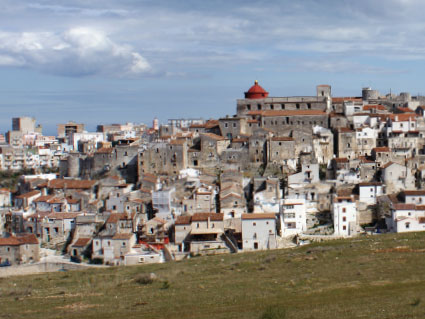




Vico del Gargano, a little town with an ancient heart, lies in a privileged position in the Montagna del Sole (as the Gargano area was once known), at an altitude of 445 metres. It sits on a rocky promontory between the sea (6 km away), with San Menaio and Calenella and the Foresta Umbra nature reserve (10 km away). It is one of the nine municipalities in the Puglia region to officially figure among “The Most Beautiful Villages in Italy”.
The gentle breeze from the hills tempers the summer heat and attenuates the cold during the winter. This ancient town, founded on top of a number of prehistoric settlements, owes its name to the Slavonians, called by Otto I in the 2nd century A.D. Vico offers visitors a delightfully attractive historic centre, organised around the three main settlements of Civita, Terra and Casale.
The town's past is evident in a wealth of findings from prehistoric times (particularly interesting are the necropoli of Monte Tabor and Monte Pucci), but it was during the Norman-Swabian period that Vico del Gargano grew and developed to a significant extent.
Traces from this period that have survived include a Castle, probably built during the reign of the Swabian king Frederick II, around 1240, and the city walls, featuring a number of watchtowers and little churches. The historic centre is organised into little streets, traditional houses of the “a pujedd” type (terraced houses with an outside stairway, rooms on the upper floor and an area under the stairs used as a shed, stable or warehouse), with the remains of the walls and the towers around it. Especially worth visiting is the “Trappeto Maratea”, an ancient oil mill, where a wooden press dating back to 1317 can still be seen; and no trip around the centre of Vico would be complete without a visit to Palazzo Della Bella, an original construction from the early 20th century inspired by the 14th century model of Palazzo Vecchio in Florence.
Just outside of the town is the enchanting Convent of the Capuchin Order, featuring a centuries-old oak tree (17 metres tall, with a diameter of 5 metres) and, inside, a Crucifix believed to work miracles, as well as a number of paintings by Vaccaro and Borghese. The Convent of Santa Maria Pura, also outside the town, is a prestigious monumental complex that is believed to have been built over a much more ancient construction, perhaps the Temple of Calchas.
In 1618 Saint Valentine was acclaimed as the Patron Saint of the town and its gardens of orange trees . The relics of the Saint are held in the Collegiate Church of Our Lady of the Assumption, and are taken out in procession on 14th February. On that day, people in love in the local area drink the juice of oranges that are blessed and believed to bring luck as a love potion; they then exchange a tender kiss in a narrow little street in the town centre, measuring just 50 centimetres wide and known as Vicolo del Bacio (Kissing Alley).
Tourist Office
Via Aldo Moro
0884 994666
Town Police
0884 991009